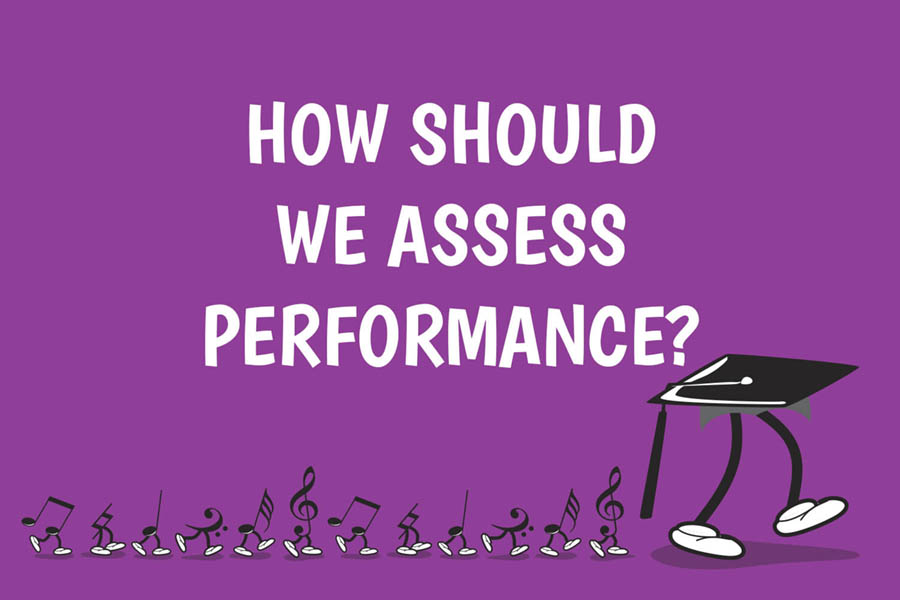How Should We Assess Performance?

What is the most important feature of a performance? Is it the rhythm? Is it the notes? Is it the dynamics, the memorisation, the fluency? Or is it something more x-factor-ish, like the general enjoyment the performer shows, the stage presence, the flair?
No matter what we think the answer is, the sad fact is that our students think it’s the notes.1 They get upset if they play a wrong note. They are frustrated if they make multiple mistakes – and the mistakes they are talking about are to do with pitch. I have rarely heard a student who has given a pitch-accurate performance come off stage and be disappointed with their fluency, dynamic range or overall expressiveness.
There is a disconnect between how we measure a good performance versus how our students measure it. This disconnect shows itself most often in reactions to exam or eisteddfod reports. Students who give pitch-accurate performances are often aghast when the report discusses all the other shortfalls. Sure, we teachers have tried and tried (and tried) to make the student understand that pitch accuracy is only one aspect of a piece… but somehow the focus remains.
Lately I have been reading Intelligent Music Teaching by Dr Robert Duke. It’s an amazing book which is making me rethink a lot of what I do and how I do it. There is one chapter in which he talks about assessments and the often-ambiguous description of the assessment goals. For example, students might be told to ‘play musically’ or ‘present a solid, competent performance’. Robert Duke asks: what do these things actually mean? If ‘playing musically’ means to pay attention to every expressive detail, then that should be the explicit wording of the assessment. If we enjoy seeing a performer play fluently and enjoy themselves, this too should be explicitly worded as part of the marking criteria.
Examination syllabuses try to be explicit. Here is the list of objectives the AMEB lists in their syllabus, for Level 1 piano exams, in relation to Section II, the performance of repertoire:
- Accuracy and fluency
- Rhythmic and metric stability
- Articulation of legato, non-legato and staccato textures as required
- Musical phrasing and punctuation
- Development of increasing awareness of the dynamic range of the piano
- Expressive realisation of dynamics
- Control of variations in tempo, tone and touch
- Control of variations in the tonal balance between the hands
- Understanding of the style and character appropriate to each work
- Execution of ornaments appropriate to each style/period
This is a reasonably comprehensive list… however it relates only to how a piece is played, and not at all to important aspects of performance like focusing before starting to play, or the importance of memorising and internalising a piece. These things are noticed by examiners and influence the overall mark, because they contribute to the effect of the performance itself.2
In another chapter, Robert Duke talks about the fact that there is no better way to incentivise people than to tell them they are going to be tested. Want students to pay attention in the lecture? Tell them there will be a quiz at the end. Want teachers to put more effort into their lesson plans? Tell them their students will be tested. Want employees to focus more? Tell them there will be a bonus for the best results that month. So what we need to do is make sure that the tests themselves focus on the things we think are the most important.
This has inspired me to create a very specific list of performance criteria that can be applied to any student, at any level, playing any piece. This list contains what I believe to be the components of any great performance, whether it’s given by the tiniest beginner pianist or the most accomplished recitalist. Teachers could give this list to any student, and ask them to address each one in their practice when preparing for any kind of performance:
Performance assessment task |
YES |
NO |
| Announces clearly (name and composer) and follows with a deep slow bow | ||
| Checks and adjusts (if necessary) piano stool height/distance from keyboard | ||
| Sits with good posture: back straight, feet flat, torso slightly forward | ||
| Thinks about the opening few bars for at least 3 seconds before commencing playing | ||
| Plays whole piece fluently without disrupting the rhythm | ||
| Plays with clear dynamics and articulation according to markings | ||
| Observes all other expression markings e.g. tempo changes, pedalling | ||
| Plays correct notes | ||
| Plays from memory | ||
| Shows enjoyment while playing, through facial expression or body language or both | ||
| Holds atmosphere at the end of the piece, then put hands in lap | ||
| Stands and faces audience with a smile, follows with a deep slow bow | ||
| TOTAL MARK OUT OF 12: |
The main point about this list is that it encourages the learning and practising of SKILLS. What we really want for our students is to develop skills that can be applied many different contexts. The twelve components above can be applied to any piece of repertoire.
I’ve thought a lot about the fact that no one aspect is weighted more than any other. One mark for each component demonstrated in the performance. Of course, a great deal more TIME must be spent on learning notes/rhythm/expression, and not much time at all needs to be spent on remembering to focus before playing or holding the moment at the end, but all of these things contribute equally to the overall effect of the performance.
The very dramatic ‘yes/no’ nature of each component of the assessment criteria leaves no room for doubt in the student’s mind. Robert Duke is very big on this. He says there is little use in having any options in between. For example, if a student makes even one pitch error, then it’s a ‘NO’ for playing the correct notes. This sounds harsh but it is very easy to understand. It is still only one aspect of the performance… in fact it is only one twelfth of the overall mark. This helps students to understand that there is a lot more that goes into a performance than playing 100% correct notes.
If we were wanting to try to be less harsh, the assessment criteria could be adjusted to say ‘Plays mostly correct notes’. And if that were the case, how does one quantify ‘mostly’? Is it 90%? 70%? 51%? This is a difficult decision and would no doubt be perceived differently between student and teacher.
It is my belief that if a student is playing with correct rhythm and expression, the correct pitches will follow most of the time. What we DON’T want is a performance with correct pitches and no expression or fluency!
I am going to try this out with all of my students. I might edit the list from time to time, depending on what I want from that particular student for that particular piece. But the main point I have taken away from Robert Duke’s book is that we should test what we believe is important, and be very explicit about exactly what we are looking for, because that is the easiest way for students to respond and eventually to learn.
- And by ‘notes’ I mean pitches.
- Memorisation is not required in AMEB exams, but any piece played from memory is duly noted by the examiner, which in my opinion implies that extra credit is given. Personally, I feel that knowing a piece off by heart means you’ll play it better anyway, which is why I always encourage performances to be from memory.

I completely agree Samantha. A performance should be a performance whether it’s an exam or recital! We teachers need to teach performing skills. Thanks for the checklist. I will try it out with my students this weekend.
I look forward to hearing how it goes Nicola!
This is GREAT–can’t wait to use it with my students. Thank you!
Thank YOU!
Thanks so much, Samantha! This will be a great tool to use at our recital rehearsal this week!
You’re so welcome!